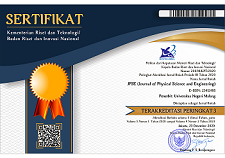Digital Simulation as Learning Aid for Heat Flow in Solid Theoretical Understanding
Abstract
Understanding the physical phenomena is extremely aided by digital simulations for understanding physical phenomena that occur, especially for students in the digital era and in this new-normal period. This paper describes heat conduction in solids using the Energy2D program, starting from general formulations for heat conduction from conductors to general solids that show the mechanism of heat conduction as a diffusion process. The thermal diffusivity parameter determines heat diffusion as the ratio between thermal conductivity and multiplication between density and thermal capacity. From the practical side, heat conduction is ordinary using thermal resistance (R-value) that combines the dimensions of the material in the direction of heat flow and thermal conductivity. By taking an analogy with Ohm's law for electrical circuits, it can be determined the equivalent resistance of several thermal resistance of the material that is composed in series or parallel. A good understanding of the heat transport process in buildings is needed for the development of technologies required for the comfort of human life and energy conservation.
Keywords
Full Text:
PDFReferences
T. Kusuda, “Fundamentals of Building Heat Transfer,” J. Res. Nation. Bureau Stand., vol. 82, no. 2, pp. 97–106, 1977.
Í. Yüksek, “The Evaluation of Building Materials in Terms of Energy Efficiency,” Period. Polytechn. Civ. Eng., vol. 59, no. 1, pp. 45–58, 2015.
M. A. Kamal, “Material Characteristics and Building Physics for Energy Efficiency,” Key Eng. Mat., vol. 666, pp. 77–87, 2016.
S. Wonorahardjo et al., “Characterising Thermal Behaviour of Buildings and Its Efect on Urban Heat Island in Tropical Areas,” Int. J. Energy and Envir. Eng., vol. 11, no. 1, pp. 129–142, 2020.
J. Trefill and R.M. Hazen, The Sciences: An Integrated Approach, 6th ed., New Jersey: John Wiley & Sons, 2010.
C. Xie, “Interactive Heat Transfer Simulation for Everyone,” J. Phys. Teach., vol. 50, no. 4, pp. 237–240, 2012.
M. W. Zemansky and R. H. Dittman, Heat and Thermodynamics, 7th ed., New York: McGraw-Hill, 1997.
D. Halliday, R. Resnick, and J. Walker, Fundamentals of Physics, 10th ed., Extended ed., New Jersey: Wiley, 2014.
F. Kreith, R. M. Manglik, and M. S. Bohn, Principles of Heat Transfer, 7th ed., Massachusetts: Cengage Learning Inc., 2011.
H. Mehling and L. F. Cabeza, Heat and Cold Storage with PCM, Berlin: Springer-Verlag, 2008.
G. Wei et al., “Selection Principles and Thermophysical Properties of High Temperature Phase Change Materials for Thermal Energy Storage: A Review,” Renewable and Sustainable Energy Rev., vol. 81, no. 2, pp. 1771–1786, 2018.
J. J. Valencia and P. N. Quested, “Thermophysical Properties,” ASM Handbook, vol. 15, pp. 468–481, 2008.
Charles Xie, “Interactive Heat Transfer Simulations for Everyone,” The Phys. Teach., vol. 50, no. 4, pp. 237–240, 2012.
M. C. Wendl, Theoretical Foundations of Conduction and Convection Heat Transfer, Saint Louis: The Wendl Foundation, 2012.
B. R. Munson et al., Fundamentals of Fluid Mechanics, 6th ed., New Jersey: John Wiley & Sons, 2009.
L. V. Heilbrunn, “The Viscosity of Protoplasm,” in Protoplasmatologia Handbuch der Protoplasmaforschung, L. V. Heilbrunn and F. Weber, Vienna: Springer-Verlag, 1958.
S. Wonorahardjo and I. M. Sutjahja, Bangunan Gedung Hijau untuk Daerah Tropis (Teori, Konsep, dan Penerapan), Bandung: ITB Press, 2018.
Y. Salu, Physics for Architects, Pennsylvania: Infinity Publishing, 2003.
J. Straube, “Thermal Control in Buildings,” Build. Sci. Digest, vol. 11, pp. 1–12, 2006.
S. Tong et al., “Thermal Performance of Concrete based Roofs in Tropical Climate,” Energy and Build., vol. 76, pp. 392–401, 2014.
A. Madad, T. Mouhib, and A. Mouhsen, “Phase Change Materials for Building Applications: A Thorough Review and New Perspectives,” Buildings, vol. 8, no. 5, p. 63, 2018.
S. Wonorahardjo et al., “Potential of Thermal Energy Storage using Coconut Oil for Air Temperature Control,” Buildings, vol. 8, no. 8, p. 95, 2018.
S. Wonorahardjo et al., “Adjustment of Indoor Temperature using Internal Thermal Mass under Different Tropical Weather Conditions,” Sci. Technol. Built Envir., vol. 26, no. 2, pp. 115–127, 2020.
S. Wonorahardjo, I. M. Sutjahja, and D. Kurnia, “Potential of Coconut Oil for Temperature Regulation in Tropical Houses,” J. Eng. Phys. Thermophys., vol. 92, no. 1, pp. 80–88, 2019.
Copyright (c) 2020 Inge Magdalena Sutjahja, Sufiyah Assegaf, Surjamanto Wonorahardjo

This work is licensed under a Creative Commons Attribution-ShareAlike 4.0 International License.
This work is licensed under a Creative Commons Attribution-ShareAlike 4.0 International License




















